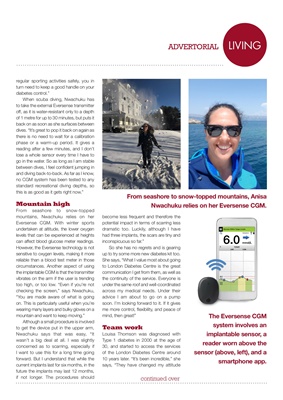
KITLIVING
regular sporting activities safely, you in
turn need to keep a good handle on your
diabetes control."
When scuba diving, Nwachuku has
to take the external Eversense transmitter
off, as it is water-resistant only to a depth
of 1 metre for up to 30 minutes, but puts it
back on as soon as she surfaces between
dives. "It's great to pop it back on again as
there is no need to wait for a calibration
phase or warm-up period before it gives
a reading and I don't lose a whole sensor
every time I have to go in the water. So
as long as I am stable between dives,
I feel confident jumping in and diving
back-to-back. As far as I know, no CGM
system has been tested to any standard
recreational diving depths, so this is as
good as it gets right now."
Mountain high
From seashore to snow-topped
mountains, Nwachuku relies on her
Eversense CGM. With winter sports
undertaken at altitude, the lower oxygen
levels that can be experienced at heights
can affect blood glucose meter readings.
However, the Eversense technology is not
sensitive to oxygen levels, making it more
reliable than a blood test meter in those
circumstances. Another aspect of using
the implantable CGM is that the transmitter
vibrates on the arm if the user is trending
too high, or too low. "Even if you're not
checking the screen," says Nwachuku,
"You are made aware of what is going
on. This is particularly useful when you're
wearing many layers and bulky gloves on a
mountain and want to keep moving."
Although a small procedure is involved
to get the device put in the upper arm,
Nwachuku says that was easy, "It
wasn't a big deal at all. I was slightly
concerned as to scarring, especially if
I want to use this for a long time going
forward. But I understand that while the
current implants last for six months, in the
future the implants may last 12 months,
if not longer. The procedures should
become less frequent and therefore the
potential impact in terms of scarring less
dramatic too. Luckily, although I have
had three implants, the scars are tiny and
inconspicuous so far."
So she has no regrets and is gearing
up to try some more new diabetes kit too.
She says, "What I value most about going
to London Diabetes Centre is the great
communication I get from them, as well as
the continuity of the service. Everyone is
under the same roof and well-coordinated
across my medical needs. Under their
advice I am about to go on a pump
soon. I'm looking forward to it. If it gives
me more control, flexibility, and peace of
mind, then great!"
Team work
Louisa Thomson was diagnosed with
Type 1 diabetes in 2000 at the age of
30, and started to access the services
of the London Diabetes Centre around
10 years later. "It's been incredible," she
says, "They have changed my attitude
continued over
ADVERTORIAL
From seashore to snow-topped mountains, Anisa
Nwachuku relies on her Eversense CGM.
The Eversense CGM
system involves an
implantable sensor, a
reader worn above the
sensor (above, left), and a
smartphone app.